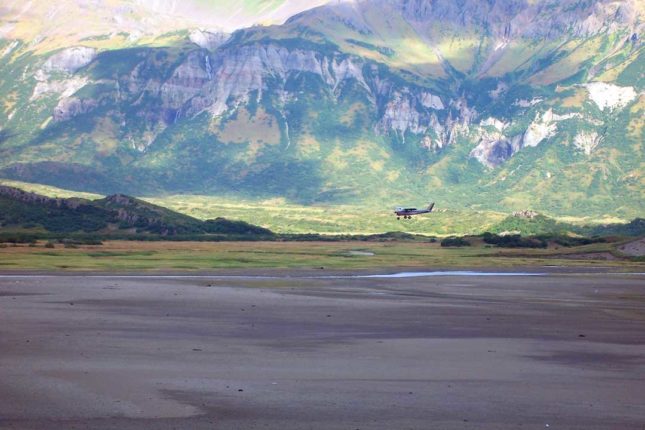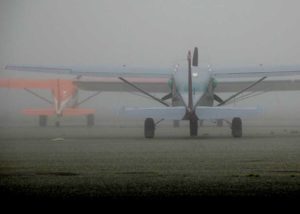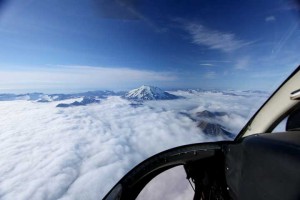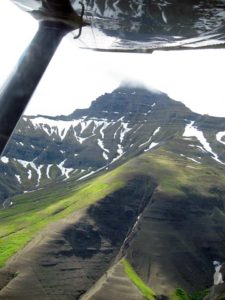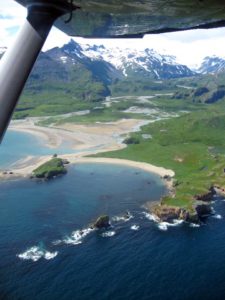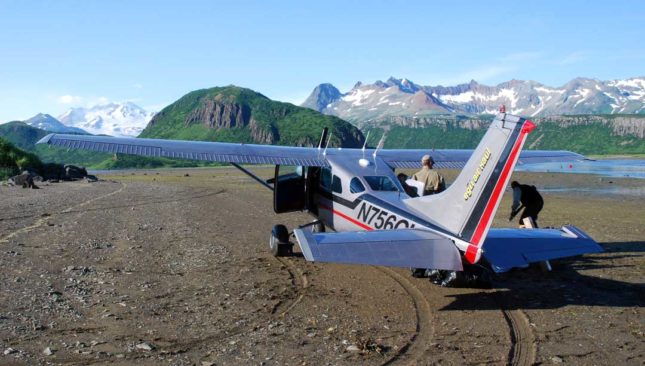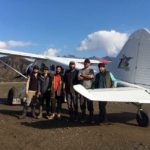Epic Blog
Homecoming
08.31.20
August, 2018. For three days we had been trying to fly to our camp, and for three days we had failed. Flights had been promised and then taken away by weather. Once we’d made it all the way through the formidable mountain passes that guard the shimmering northern Pacific only to be met with a sea of blanketing clouds. They shrouded the coastline for as far as the eye could see. Finally, in defeat, we banked hard over the blue ocean and began the long flight back to the town of King Salmon.
Now it was time to try again. We clutter aboard our pilot’s red and white de Havilland Beaver, the classic bush plane and iconic work horse of the far north, and set out once more for our remote wilderness camp on the rugged Pacific coast of the Alaska Peninsula.
1,000 small mirrors
Over the deafening drone of the radial engine we gain altitude and set our course due south. Below us the thin veil of stunted spruce quickly disappears, giving way to a boundless expanse of rolling tundra. It’s littered with what seems to be a thousand muskegs. Each one perfectly reflecting the grey mantle of sky as we pass overhead like an endless array of small glimmering mirrors. We approach the shores of Becharof Lake, a lake so large that from up here it looks like an inland sea. The snow capped dome of volcanic Mount Peulik rises from its southern shore, resolute and alone.
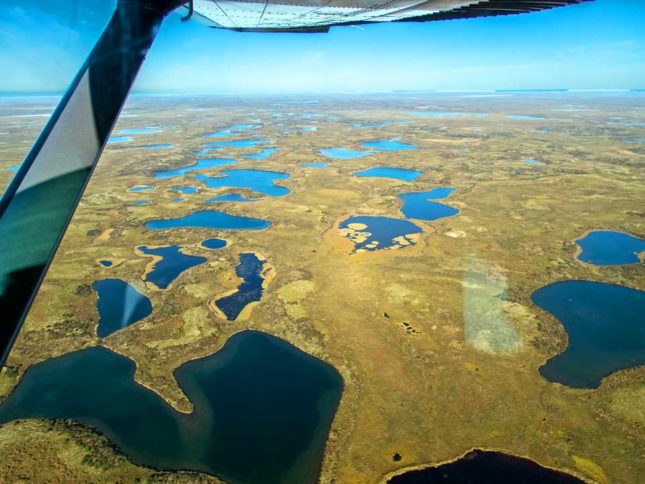
The Bering side of the Alaska Peninsula is decorated with thousands of small tundra ponds and lakes. On the day of this photo, passengers are treated with blue skies.
We fly over the two Ugashiks, two massive lakes separated by a thin corridor of water that joins the two, the Narrows. Normally this is where we would make our break for the Pacific, but the passes are fortified by clouds; our pilot makes another plan. We keep to the west of the towering Aleutians, venturing further south down the long arm of the Peninsula.
Under the Volcano
Hugging the mountains we draw nearer to the massive volcano that rises from the surrounding peaks like a temple rises from the mound upon which it is built. This is Mount Chiginagak; snow covered, shedding rivulets of water from its towering flanks that cascade down into impenetrable canyons. Ultimately coursing their way into the valleys below where they converge to form creeks and then rivers that meander from here all the way to the sea. On the other side of her is our camp, but we must find a way through before we can be reunited.
All is not lost
We keep our south heading. The cabin of the plane rattles like a can of paint as we push through rough air coming off the mountain. Soon we will know if our long flight deep into the heart of this vast wilderness will bear fruit or not.
We aim for a low pass separating the two worlds of the Bering and Pacific. All is eager anticipation as we crest the heights of the tallest ridge and drop down into the head waters of a nameless Pacific drainage. We get our first view of the remote Pacific side of the Aleutians, and what we are greeted with is an unwelcome sight. A thick soup of low lying clouds obscures the ground. We get a few fleeting glimpses where pockets have opened in the cloud cover, revealing momentarily the cobbled gravel bars and river flowing steadily below. We can barely make out land’s end, where the river snakes into a tidal bay guarded by formidable rocky headlands. Our pilot scans the horizon, looking for some sign of hope amongst the enveloping wall of clouds.
We are moments from turning the plane around when Rus, who is sitting next to the pilot in the cockpit, points ahead to where a large opening in the clouds seems to be forming out over the ocean. It’s the moment we’ve been waiting for, our window of opportunity. The pilot throttles down, dropping us through the portal into the world below.
The eternal coast
We have made it through. Beneath the ceiling of clouds a world that few people will ever see with their own eyes is revealed in dramatic fashion. The Pacific coast of the Alaska Peninsula, where the largest ocean on earth runs into a fortress of volcanic mountains extending down the length of its long spine. Sea stacks stand watch offshore, facing the brunt of the cold and ill tempered seas. Islands loom far off on the horizon as we bank over the pitched waves and point the nose of the plane north to our home bay.
Now we fly along the eternal coast, a name given to the Pacific coastline of the Americas for its geological endurance. For as long as there have been continents, going back in time to the age of Pangea, this has been the place where the land meets the sea. It is written on the numerous rocky cliff faces that spill into the ocean along this desolate coastline that we now glide over. There you will find entombed in stone the story of the world fossilized for all eternity; ferns, ammonites, and traces of our oldest and most common ancestor, the first vertebrate on earth, the fish.
The Nak
The coast is clear as we make our way north to the yawning mouth of our home bay. The shadow of the plane dances below us, undulating over the rocky surfaces of land, quickly reforming its shape as we move back over water. We pass the last headland and then bank over the entrance to our final destination, our home for the next two months, Nakalilok.
Finally we have returned to the place that will become our camp; perched above the ceaselessly flowing tides, nestled alongside the furthest reaches of the Northern Pacific, and under the looming volcano that towers over all. Here is one of the last truly remote places left to us, a virtual paradise. The weeks ahead will be filled with days of endless work as we build our camp, but we have made it. At long last we are here.
Written by Drew Griffith (aka “Machete”). July, 2020
Find more Machete articles here.
Posted in All Posts, Guide Journal, SAFARI

